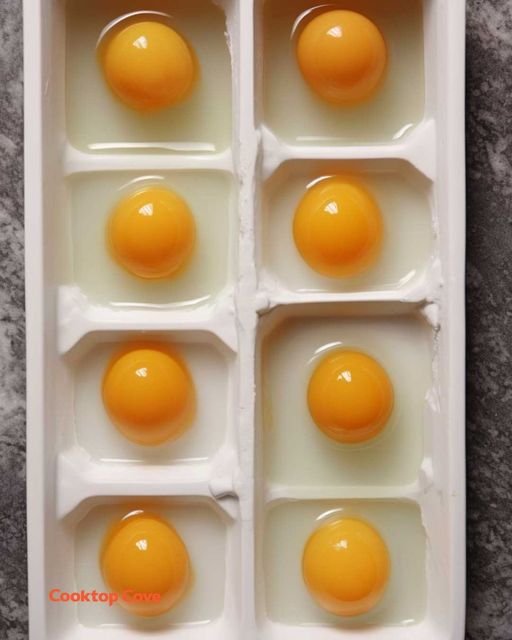ADVERTISEMENT
How to Freeze Eggs
Freezing eggs is a simple process:
1. Crack an egg into each separate mold of ice cube tray. Each compartment should hold the equivalent of one egg.
2. Place the tray in the freezer and allow the eggs to freeze solid.
3. Once frozen, pop the egg portions out of the tray and transfer them to a labeled freezer bag or container. Be sure to date the container for reference.
How to Use Frozen Eggs
Before using frozen eggs, you'll need to thaw them. There are a few methods to do this:
At Room Temperature: Just leave the frozen egg cubes in a bowl and have it come to room temperature.
In the Refrigerator: Transfer the frozen egg portions from the freezer to the refrigerator and allow them to thaw overnight or for at least 12 hours.
In Cold Water: Place the frozen egg portions in a sealed, airtight bag and submerge them in cold water. Change the water every 30 minutes until the eggs are thawed. This method is quicker than using the refrigerator and usually takes a couple of hours.
In the Microwave: If you're in a hurry, you can thaw frozen eggs in the microwave using the defrost or low power setting. Be cautious not to cook the eggs during this process, as they can become partially cooked.
Cooking with Thawed Eggs
Scrambled Eggs: Thawed eggs work well for making scrambled eggs. Whisk them with a bit of salt and pepper, then cook them in a pan with butter or oil over medium-low heat until they reach your desired level of doneness.
Omelets: You can use thawed eggs to make omelets with various fillings like cheese, vegetables, or ham. Whisk the eggs, pour them into a preheated pan, add your fillings, and fold the omelet when it's almost set.
Baking: Thawed eggs are suitable for baking recipes that require eggs as an ingredient. Simply use the thawed eggs as you would fresh ones in your recipes for cakes, muffins, quiches, and other baked goods.
Frittatas: Frittatas, a type of Italian omelet, can be made using thawed eggs and a variety of ingredients such as vegetables, cheese, and meats. Pour the whisked eggs into an oven-safe skillet, add your desired ingredients, and bake until the frittata is set.
Custards and Puddings: Thawed eggs can also be used for making custards and puddings. Follow your recipe's instructions, and incorporate the thawed eggs as needed.
Is This Hack Recommended?
Freezing eggs can be a practical and cost-effective solution for many households. However, it's essential to consider a few factors before adopting this hack:
Quality:
While frozen eggs retain their safety and nutritional value, the texture may change slightly upon thawing. They may become slightly more watery, which can affect the outcome of some recipes. It's best to reserve frozen eggs for dishes like scrambled eggs, omelets, and baking, rather than recipes that rely on the texture of fresh eggs, such as poaching or sunny-side-up eggs.
Space:
Freezing eggs requires storage space in your freezer. Ensure you have enough room to accommodate the extra containers or trays.
Labeling:
Properly label frozen eggs with the date to keep track of their freshness.
ADVERTISEMENT
